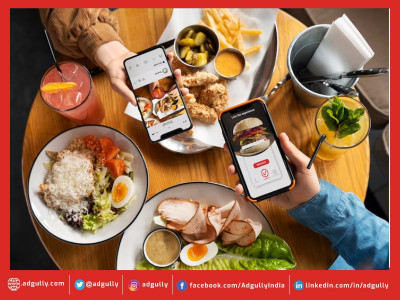How consumer behaviour in the food & beverage industry is evolving
The food and beverage industry in India is one of the high profit industries. As per Statista, the revenue in the Food market in Indi amounts to $963.60 billion in 2023. The market is expected to grow annually by 7.23% (CAGR 2023-2027). According to management consulting firm Technova, the food and beverage industry accounts for about 3% of India’s GDP and around 2/3rd of the total retail market in India. In fact, the revenue in the food and beverage business segment is estimated to show a CAGR growth rate of 14.2% from 2020-2024. Also, the projected market volume is $1,264 million by 2024.
From neighbourhood kirana stores to online stores, the F&B industry has seen massive changes. The events of the past two years have accelerated both consumers and businesses. The shift towards e-commerce is evident and will continue to evolve in the coming years. As branded content has appeared on streaming video platforms, there has been a growing trend towards branded storytelling. A change in customer behaviour has led to a new purchasing approach.
Brands have revised their strategy to reach customers using digital tools and e-commerce platforms like Amazon, Flipkart and Snapdeal to name a few. There is no doubt that rural demand will increase in the coming years. Digitization would come first, along with the demand for packaged food. Online stores will gain the most importance, so brands that work with local and online platforms will benefit.
On how the changes in this industry have reshaped the consumer demand and consumer behaviour, Mayank Shah, Senior Category Head, Parle Products, noted, “We have observed a considerable increase in spending, which has been spurred by the rollout of 5G services. The introduction of 4G technology, combined with the low cost of smartphones, resulted in seamless streaming and networking via digital mediums. In terms of overall media promotion and consumption, 5G will be a game changer. Marketers have been challenged to think creatively and use social media or digital channels to build brand loyalty. OTT platforms acquired the most popularity as consumers discovered on-demand content, greatly increasing screen time in both rural and urban areas.”
FMCG has traditionally relied on long-standing brand loyalty. The first and most important stage is to establish the target demographic for the businesses, Shah added. He further noted, “As a highly traditional and ancient market, our sector has a diverse client base ranging from older residents to our very own millennials. Unlike many businesses that have catered to a narrow set of consumers, the appropriate balance for us as a brand is to satisfy and remain relevant with a wide range of age groups.”
“With millennials being exposed to a wide range of technology and products from around the world, the FMCG market is under pressure to remain ‘quiet’ in order to retain this generation’s customers. Finding a happy medium is critical. We believe that continually evolving marketing methods, digitalisation, and easy accessibility will assist us in striking this balance,” Shah continued.
The adoption of the plant-based meat segment is just getting stronger, with consumers becoming more receptive to the category, more and more start-ups and leading FMCG players entering the segment, celebrities and athletes backing it and big investments coming in. Sohil Wazir, CCO, Blue Tribe, explained, “Conscious consumerism has picked up and how. It all has spiralled up in just the last two and a half odd years with Gen Z, millennials, and Gen Alpha making a transition towards a well-balanced and ethical lifestyle, food choices, and keeping their choices guilt-free. An interesting thing to note is that 90% of our target audience are non-vegetarians who are trying to reduce their meat consumption.”
Consumers are looking for quick and easy options when it comes to food, which has led to an increase in mobile ordering options at QSRs. Many QSRs have also implemented self-service kiosks and mobile apps to make the ordering process even more convenient for customers.
Viren D’Silva, Co-founder, Good Flippin’ Burgers, stated that with the rise of food delivery apps like Zomato and Swiggy consumers have grown accustomed to being able to order from their favourite QSRs and have it delivered to their door. He added, “Consumers are looking for more personalised and customisable options when it comes to their food, which has led to many QSRs offering build-your-own options, such as customisable Burgers in our case. The changes in the QSR industry have reshaped consumer demand by making convenience, customisation, and technology integration key factors in their offline and online experience.”
Microbreweries
With the microbrewery landscape rapidly changing, newer entrants with an appetite for risk entering the market, innovation has grown by leaps and bounds, and so has the awareness about craft beers. This has led to demand and growth and as is obvious, the adoption of craft beer as a lifestyle choice has gathered steam. Taste palates are evolving and people are appreciating the nuances of different types of beer and gravitating to freshly brewed beer rather than the bottled beer.
With consumer behaviour being a function of availability, awareness and supply - as more entrants enter the market with bolder varieties, innovation will get a shot in the arm, shared Teja Chekuri, Managing Partner, Ironhill India. Adding further, Chekuri said, “We believe this will trigger a migration of consumers from the traditional varieties to bolder, innovative styles. This combined with the consumer tending towards gaining a holistic experience through value added events and products, rather than just low priced products and offers, we will certainly see an explosive growth in the craft arena.”
“The industry will certainly see intense competition, with larger brands beginning to vie for a piece of the craft pie,” Chekuri concluded.




Share
Facebook
YouTube
Tweet
Twitter
LinkedIn